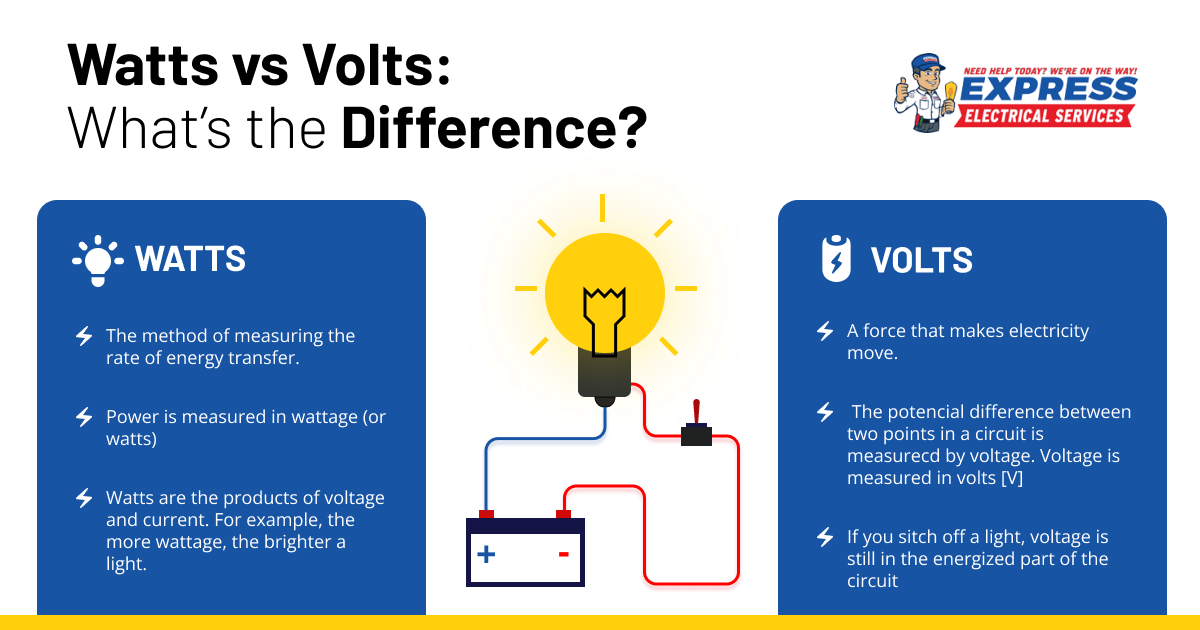Watts vs. Volts: What’s the Difference?

Whether you’re switching to greener light bulbs or installing a solar system to save on your California energy bill, knowing the difference between volts and watts is important for understanding your home’s wiring and electrical system. Watts and volts are often referred to interchangeably, but the main lies in which aspects of electricity they measure.
Watts vs. Volts
Check out this infographic describing the difference between volts and watts:

What Are Volts?
Volts (V) are the unit of measure for electrical voltage. Electrical voltage, called electromotive force, is the potential pressure that pushes a given electrical current through a connection or conductor.
Compare it to plumbing — similar to pressure forcing water along a pipe, voltage pushes electrons through the conductor to initiate the electrical current.
Volts are an important measure for understanding compatibility between power sources and devices. Improperly matched voltage can result in underperformance, electrical malfunctions, breaker trips, or damage to electric devices. For example, consider a basic AA battery with 1.5 volts. While this voltage is sufficient to charge TV remotes or similar items, you’d need an electrical outlet offering about 120 volts for the electrical currents required to adequately power appliances and similar household items.
The main sources of voltage are:
- Batteries
- Solar cells
- Generators
What Are Watts?
A watt is a unit of power that describes the rate of power flow per second. Using the plumbing analogy above, a watt is the rate at which water moves through a pipe as opposed to the force pushing it. This measure is the product of an amp flowing through an electrical difference of one volt, which is expressed as the following formula:
- Voltage (V) x amperage (A) = watts (W)
At one amp, a volt is equal to one watt. At higher amperage, the number of watts multiplies — for example, if a device uses 10 amps and 200 volts, it’s expressed as:
- 200 V x 10 A = 2,000 W
Wattage, which is like horsepower in an engine, helps determine the energy needed to perform a task or generate heat. Lightbulbs, for instance, come in various wattage ratings that represent their performance. Low-wattage light bulbs, such as 15 W lights, require a lower rate of power flow than a 60 W bulb. This wattage difference is represented in their power consumption, with the 15 W bulb using less power but emitting less light and the 60 W bulb using more power but likewise generating more light.
Utility companies charge electricity usage, expressed in kilowatt-hours (kWh) based on watts or power consumed over a given time. A 60 W light bulb powered over 10 hours, for example, consumes 0.6 kWh of energy. Wattage ratings can help determine how much a device costs to operate in relation to your local Southern California electricity rates.
Differences Between Watts and Volts
Volts and watts measure different aspects of electricity. Voltage represents the push of a current, the electrical potential, while watts represent the flow of power rate, otherwise called energy consumption. In the case of a household device such as a light bulb, volts measure the force that pushes the current through the bulb’s circuit while watts quantify the bulb’s power consumption.
The Relationship Between Watts and Volts
The relationship between watts and volts is a concept necessary for understanding the design of electrical circuits and how items in your home use electricity. To understand the relationship between volts and watts best, consider the following terms:
- Ohms: Measures resistance, which is how easily electrons move through a material.
- Amperage: Refers to the volume of electricity (electrons) running through a circuit. Circuits are often labeled with the maximum amount of amperage they can handle, with larger amperage circuits allowing more electrical current before they overload.
Watts, volts, amperage, and ohms relate to each other across several calculations, which is described in Ohm’s Wheel Law. These formulas help determine electrical requirements for how to most efficiently power an appliance, circuit requirements for certain devices, and more.
For instance, watts divided by volts for a given device provide the amperage required to operate. If a fridge consumes about 600 watts and uses 120 volts, it needs to be powered by a circuit rated for at least five amps.
Volts, Amps, Watts, and More at Express Electrical Services
Understanding the difference between watts vs. volts is important for assessing the electrical needs of devices and circuits throughout your Southern California home. When it comes to more advanced needs such as electrical repair, maintenance, or electrical installation, our licensed electricians at Express Electrical Services can provide reliable and safe services and help take the guesswork out of understanding complex electrical systems.
With around-the-clock and same-day service and live operators, it’s no wonder we have plenty of satisfied customers across Los Angeles and the rest of Southern California. Contact us to request a service call or get expert electrical advice.

Leave A Comment